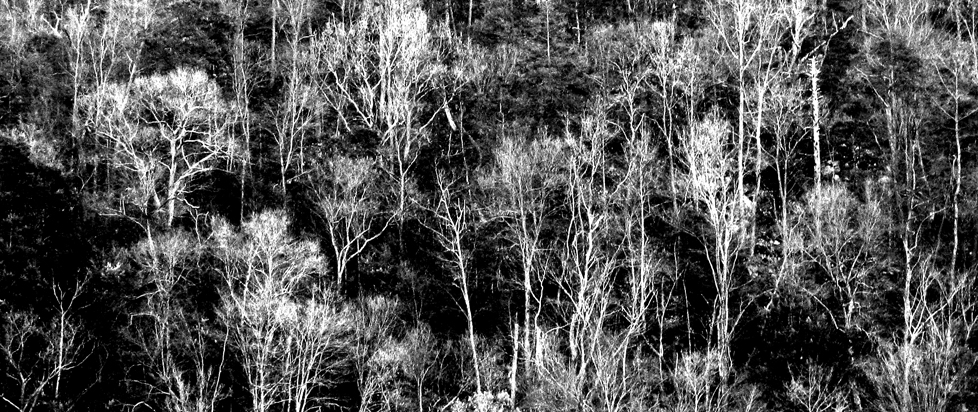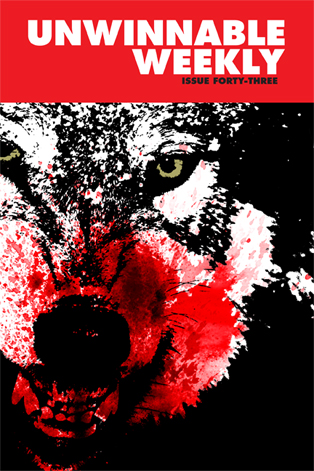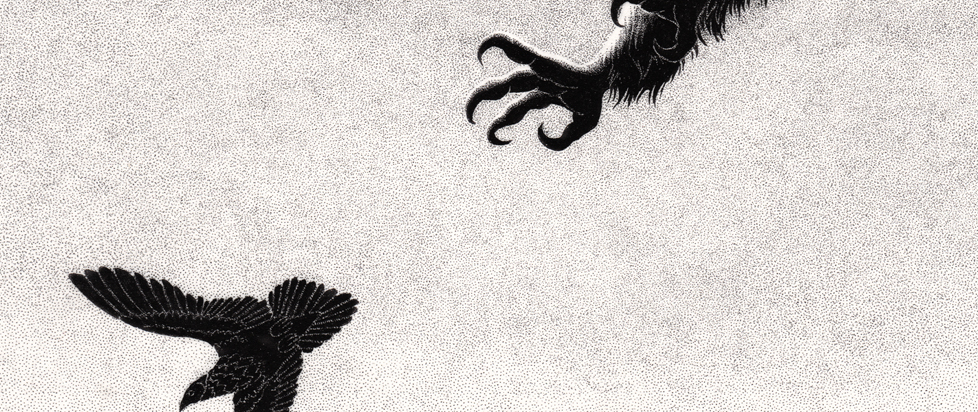
The Woods are Dark and Deep: An Interview with John Langan
 John Langan is a maker of traps. He constructs them out of words that, on the surface, seem literary, even genteel. The words greet you, shake your hand, offer you a drink. They form a comfortable chair of leather and wood, well loved, perhaps alongside a fire. You read and you sink into that chair. They say to you, “This is horror, yes, but familiar. You have nothing to fear. Relax.”
John Langan is a maker of traps. He constructs them out of words that, on the surface, seem literary, even genteel. The words greet you, shake your hand, offer you a drink. They form a comfortable chair of leather and wood, well loved, perhaps alongside a fire. You read and you sink into that chair. They say to you, “This is horror, yes, but familiar. You have nothing to fear. Relax.”
And you do.
And as soon as you do, the trap is sprung. The charming host vanishes into the shadows and the unyielding metal teeth snap shut, sheering flesh and crushing bone. Such is the impact of those sweet words when their true meaning becomes clear.
“The Revel” is a perfect example of this. If not quite my favorite of Langan’s tales (that would be “Mother of Stone”), it is certainly the one I haven’t been able to shake. I can still feel its hooks stuck in the base of my brain.
It is a werewolf story. Having just read that, I imagine you now have Lon Chaney Jr., or some similar movie wolf man in your mind’s eye, a man with fur that appears in a series of dissolves, familiar, vaguely ridiculous. The story is content to let you cling to that image. It even encourages it. The narration takes place somewhere far above the action of the story, like a camera on a boom, and busies itself with describing the conventions of the werewolf movie.
Yes, a creature is killing a man in the forest down below, but pay them no mind. Their screams aren’t so loud all the way up here.
Except you can’t ignore them. Despite the apparent detachment of the narration, something keeps drawing you down to the ground. Whether as the man in the woods, the hippie fortune teller, the sheriff or the werewolf itself, you find yourself seeing through the eyes of each in turn, the sudden shifts in perspective illuminating and disorienting simultaneously. The narrator’s voice is distant, in the clouds above, a drone that pretends to alleviate the terror while really accentuating it.
Langan performs a kind of vivisection on the subjects of his stories, reducing them to their essential parts and re-arranging them into something freshly terrifying. Every story helps cut a new border for the horror genre — he was kind enough share with me some of the sharpest instruments secreted within his bag of tricks.
Unwinnable: Since you teach, and much of your work seems preoccupied with the mechanics of the genre, can you tell me what you think makes for a great horror story? Do you make much a distinction between horror as a whole and the sub-genres like cosmic horror, weird fiction, literary horror, dark fiction, etc.?
Varieties of Horror: On the one hand, I love parsing distinctions; it gives me an almost monkish pleasure to discuss the differences not just between cosmic horror and dark fantasy, but among different kinds of vampire stories. I suppose that’s because, at root, I’m deeply interested in literary form, which is for me an enduring source of narrative. On the other hand, I think that the various subsets of horror tend to share certain underlying concerns, in particular, what Stephen King called “a pervasive sense of disestablishment, a sense that things are in the un-making.” Lately, I’ve found myself paraphrasing a quotation from Jim Thompson: “There are thirty-two ways to write a story, and I’ve used every one, but there is only one plot – things are not as they seem.” Things are not what they seem and, in a horror narrative, that’s unlikely to be a very good thing.
To expand just a little bit on that: I think that most of what falls under the umbrella of horror tends to begin with characters and a setting that seems recognizable to the reader — often, that fit a loosely-defined mimetic naturalism — and then introduces elements that challenge and even subvert those familiar aspects in a way that the characters experience as a subversion, a violation of the norm. Sometimes the violations are going to be subtle, sometimes they’re going to be obvious. The writer may choose to focus on the fact of the violation, or on the characters’ response to it. I know there’s a school of thought that differentiates between those horror narratives that end with the defeat of the violation and those that end with it undefeated, persistent if not outright victorious, but this seems to me a distinction without a difference. Even if the monster has been destroyed in the best traditions of 1950s-era big-bug films, any reassurance its destruction causes is attenuated by the fact of its existence in the first place. Thematically, it seems to me that horror is fundamentally concerned with the abyss, with those places where sense breaks down outside and also inside the self (maybe more inside than outside). (Maybe.)
Greatness: As for what makes a great horror story, I think that’s pretty much the same as what makes for a great story in general, namely, the sense that we’re reading the expression of a specific, unique sensibility. I think of the horror stories I esteem most highly, Sheridan LeFanu’s “Green Tea,” or Henry James’s “The Jolly Corner,” or Walter de la Mare’s “Seaton’s Aunt,” all exemplify this. Granted that greatness can be a highly subjective term, I tend to think that it lies in some element (or combination of elements) in the story that is fundamentally compelling to the reader, whether it’s the portrayal of character, narrative arrangement, authorial voice, style, thematic content, etc.
You’ve been a character in several of your stories, as the receiver of a story — not unlike the wedding guest being stopped by the ancient mariner (“On Skua Island,” House of Windows). In other, perhaps more obliquely (“Technicolor,” “How the Day Runs Down” and “The Revel”). It strikes me that this makes a story more believable just as much as it can wrap it in the air of an urban legend. What are your intentions when you use this device?
Storied Traditions: I’m very much interested in the process of storytelling, in the way(s) in which the narrator’s voice interacts with the substance of their story. I suppose it has to do with reading and studying a lot of Modernist classics, in which the act of narration is put front and center, i.e. Heart of Darkness, Ethan Frome, My Antonia, The Great Gatsby, The Sun Also Rises, All the King’s Men. Not to mention, the work of someone like Faulkner, which places center-stage the different voices of his characters, and the manner in which they express their differing versions of and responses to events (a novel like Absalom, Absalom is a kind of master class in the uses of voice and narration).
In the last few years, I’ve been reading a lot of the poetry of Robert Browning, and you find similar things occurring in his dramatic monologues (and in his novel-in-verse, The Ring and the Book). And I love those stories of Isaac Bashevis Singer’s in which he answers a knock on the door from a man or woman who confirms his identity, then announces they have a story for him, which they proceed to tell.
Storied Lives: Our lives, it seems to me, are fundamentally story-shaped. Their courses are profoundly affected by the narratives to which we’re exposed from our earliest days on. We conceive our lives as our personal stories. We understand new experience through a narrative framework. Given how basic narrative is to our consciousness, it struck me that it would be interesting to write stories in which the process of narrative is foregrounded in one way or another.
Storied Family: To a certain extent, my interest in storytelling owes a lot to my father, who was an inveterate storyteller, both of events from his life and of the plots of various movies and books, which he would recount me to me in great detail. My mom, too, is full of stories. I suspect this had to do with them growing up in Scotland, which has a tradition of oral storytelling, in the years after the Second World War, when the options for entertainment were somewhat more limited than what we have today (to put it mildly). I suppose the experience of listening to my parents’ stories made me particularly receptive to those narratives (i.e. Conrad, Cather, Fitzgerald) in which the narrator is part of the action but also set at a slight remove from it.
Storied Me (I): In using the device in my own work, I’m placing myself in a narrative tradition that, of course, has had some notable instances within the horror genre (think The Turn of the Screw, or Ghost Story). I very much like the idea of people facing things that are at the edge of or even beyond the limits of their comprehension, and then trying to make sense of them by narrating them.
To be honest, I hadn’t thought of it in those terms, but I very much like the idea expressed in your question, of a narrative technique that cuts in two, seemingly opposite directions, towards the folkloric and towards the personal. It strikes me that so much of the literature that’s endured through the ages combines those qualities, which may help to explain why the framed narrative has lasted as long as it has.
Storied Me (II): Does my use of this device also reflect my own sense of being the kind of person who has more stories of other people to tell than he has of himself? Probably.
“The Revel” works as a deconstruction of werewolf movie tropes and a rumination on the interplay between horror prose and horror movies, as well as being a horror story itself. How do you approach this kind of narrative dissection? How do you balance these elements against themselves?
The Dissection: An early draft of “The Revel” was the first thing I worked on when I returned to writing horror fiction (this would have been in the summer of 1999). I think I must have had John Barth’s “Lost in the Funhouse” somewhere in the back of my mind, but to be honest, the voice of the story poured out of me. I read the draft to my-then-future-wife as I was writing it and she would tell me when I had strayed too far from the narrative into commentary. Certainly, I took an everything-but-the-kitchen-sink approach to writing the story; I suppose you might call it my attempt at a tour-de-force. When I began the story, I was writing more academic, critical work than fiction, which probably played a role in my approach to it. My critical training helped me to be aware of the elements that go into a werewolf narrative, as did my conversations with Fiona.
The Balance of the Gun, or, The Tarrantino Effect: I’m not certain you could make a rule of this, but one of the things (I think) I learned is that, if you present the more explicitly analytical portions of a story within a compelling narrative context, then you can get away with a great deal.
The example I would give from “The Revel” is the section on the forest, in which the scene simultaneously discusses the role of the woods in horror stories and literally places the reader within that scene, being chased by the werewolf. It’s an example of what you might call the Tarrantino effect. One of the things Quentin Tarrantino demonstrates in a movie like Pulp Fiction is that, if your characters are holding guns on one another, you can discuss all kinds of weighty ideas, and people will pay careful attention, because of the threat of all those guns.
You’ve been reading an excerpt from Unwinnable Monthly Issue 43.
To read the article in its entirety, please purchase the issue from the shop or sign up for a subscription to Unwinnable Monthly!




